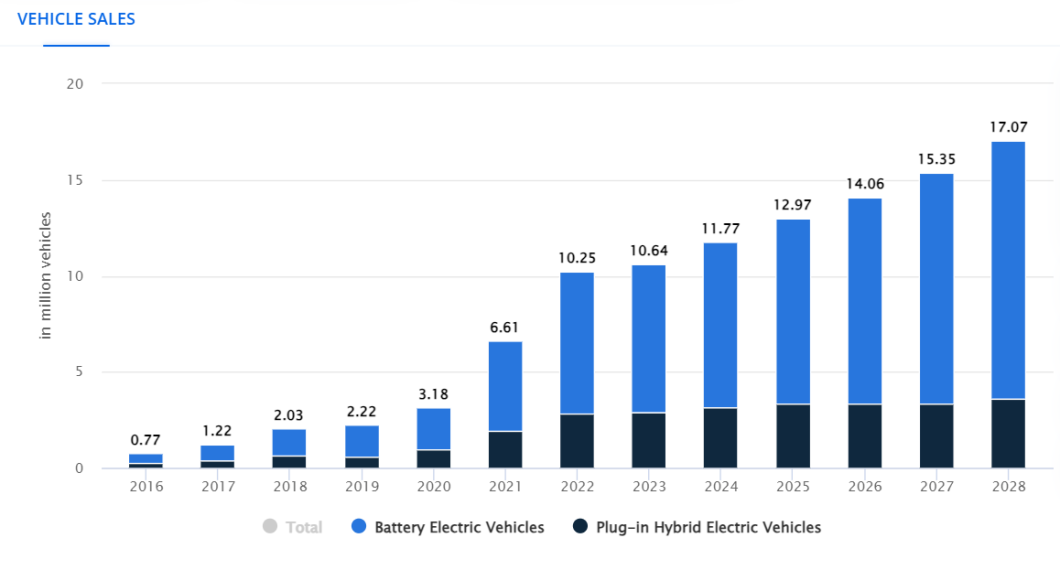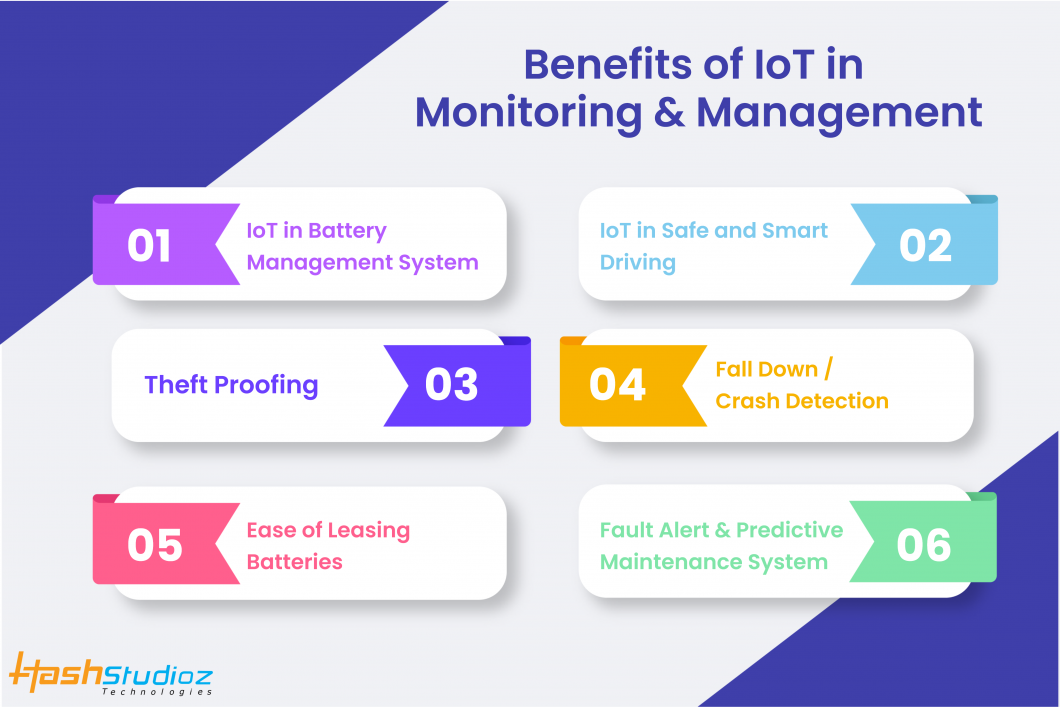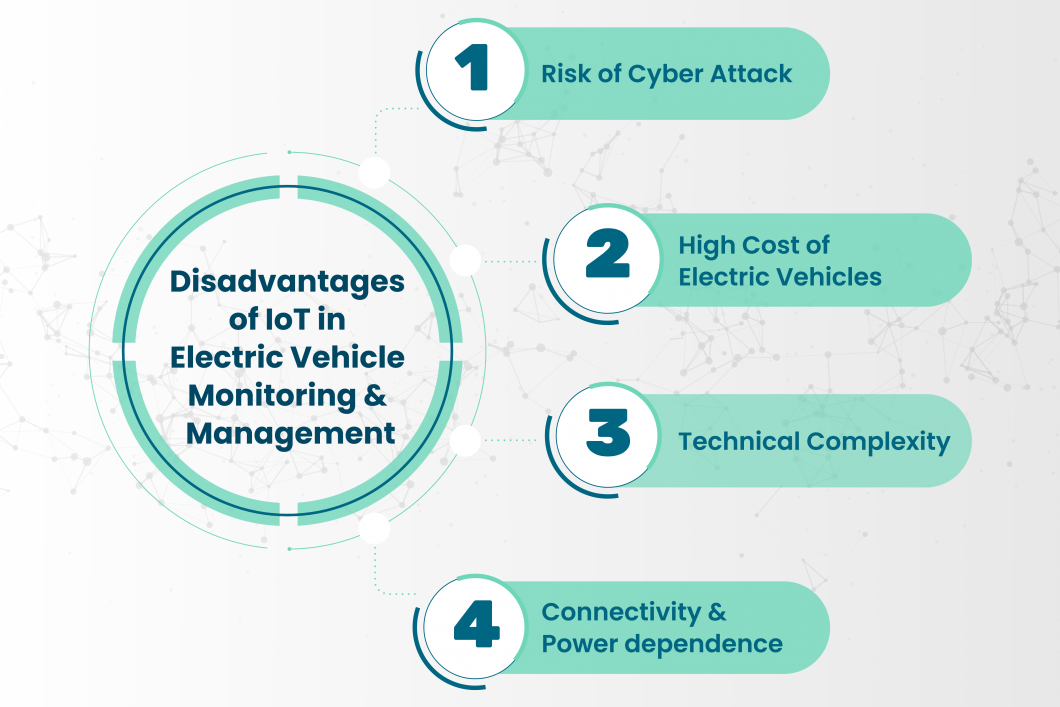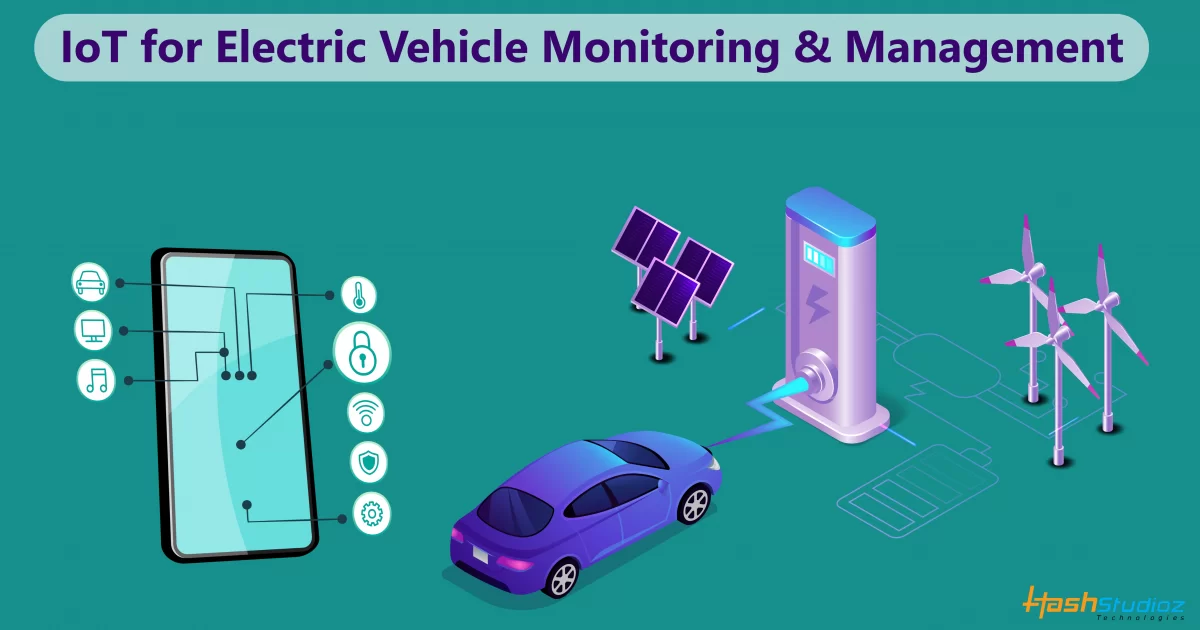As the level of air pollution continually rises and the degradation of the environment increases, the entire world is searching for different ways to tackle this problem. One of the best ways to control air pollution is to reduce vehicular pollution. Electric vehicles (EVs) are a ground-breaking step taken in this direction. The use of IoT can help companies to get various insights about Electric Vehicles and help them to improve customers’ experience.
The global electric vehicle market is expected to reach a staggering US$623.3 billion in revenue by 2024, and is projected to grow at a steady CAGR of 9.82% from 2024 to 2028. This growth will lead to a projected market volume of US$906.7 billion by 2028, with 17.07 million vehicles expected to be sold that year. The average price of an electric vehicle in 2024 is predicted to be US$52.9 thousand.

Image Source: Statista
Electric vehicles are hi-tech machines that collect a lot of data to deliver optimum performance to the users. IoT plays a vital role in monitoring performance parameters, including speed monitoring, acceleration, mileage, battery management, charging, fault alert, and service maintenance systems.-
In this article, we explore the aspects of an IoT for electric vehicle monitoring & management system.
Table of Contents
Benefits of IoT in Monitoring & Management
Let’s take a look at some key features of IoT in electric vehicle monitoring & management systems, and the different ways in which they increase the overall performance of electric vehicles:

1. IoT in Battery Management Systems
Battery Management System (BMS) is mainly used to monitor and control the process of the battery. The BMS helps to monitor the charging and discharging cycle of the battery ensures the battery’s health and also minimizes the risk of damage by confirming that enhanced energy is being delivered to power the electric vehicle.
In the Battery Management System (BMS), the monitoring circuit monitors the key parameters of the battery. This will include the voltage, current, temperature, and temperature during the charging and discharging of the battery. It also evaluates the key parameters of the battery such as the power, State of Charge (SoC), and State of Health (SoH), and enables the healthy life of the battery based on the measurement. Internet of Things.
(IoT) plays a vital role in monitoring and controlling the battery lifecycle as it enables the remote data logging facility for battery parameters, conditions, etc.
2. IoT in Safe and Smart Driving
By using IoT, we can monitor the real-time data of the vehicles and their key components. It provides users with a bunch of information offered by the technology, making the users find it more reliable.
IoT devices embedded in Electric Vehicles can provide users with the following information:
- It helps in monitoring the driver’s performance and the key parameters like the speed of the vehicle, acceleration, and temperature, and provides real-time tips to ensure better performance.
- We can prevent the theft of vehicles through real-time tracking, geo-fencing, and immobilization. Thus, IoT provides better safety and security and reduces the dependency on insurance.
- IoT will monitor the performance data of the vehicle based on which EV and battery manufacturing companies can improve their products. The data provided by IoT includes a range for each charge, battery life cycle, utilization of a vehicle, performance differences based on geography, weather conditions, age, and change in range for each charge over a certain period of time.
3. Theft Proofing
The current prices of Electric Vehicles are more expensive than the normal petrol or diesel engine-based vehicles. Two-wheelers are more prone to theft, as the cost of a battery is expensive, and IoT could help in more effective tracking. The cost of the battery alone is 40% of the total cost of EVs. So, it is very necessary to protect them from theft. Electric Vehicles are also used by on-demand app companies for food delivery, cargo delivery, bike-sharing, hyper-local delivery, etc. In such situations, IoT can be used to track down the real-time location of EVs in case they are stolen. These IoT devices can also raise an alarm and notify the owner about the theft.
4. Fall Down / Crash Detection
Most IoT devices have built-in accelerometers which can monitor the acceleration and angle of the vehicle. So, if there is a sudden change in acceleration and angle of the vehicle can be detected easily by IoT, and it notifies the owner about a fall or crash. This can also be very useful to inform about severe accidents.
5. Ease of Leasing Batteries
The performance and location tracking of batteries is one of the most important features for battery swapping and leasing companies. The swapping of batteries can be easily tracked and monitored from the swapping stations. To track or monitor the batteries IoT can play a major role and also prevent the theft and loss of the battery.
6. Fault Alert and Predictive Maintenance System
An electric vehicle, being a high-tech machine, is bound to experience technical faults. Using IoT Fault alert systems, it alerts vehicle drivers regarding faults or glitches and gives them enough time to act and address them.
By using an IoT we can detect the charge cycle of the vehicle, kilometers traveled, the temperature of the battery, etc. and we can use this data for regular maintenance of the tires, lubrication cycle, battery life, and monitoring other wear and tear parts of the vehicles and replacing them on the time. This could help in averting the damage to the vehicle and also help in increasing the life of the vehicle and its batteries. This will help in better customer experience as they will find it to be more reliable.
IoT’s Disadvantages in Electric Vehicle Management and Monitoring
As we already saw the advantages of IoT in Electric Vehicle Monitoring and management, now we must also address possible challenges:

1. Risk of Cyber Attack
Since we have added so many devices to the Internet the use of a high amount of data sent over a network makes this data more vulnerable to cyber-attacks and data thefts. Hackers may access the system and steal personal information and it can be misused. Therefore, the IoT devices connected to the EV and collecting the overall data should be strengthened and made more hackproof.
2. High Cost of Electric Vehicles
IoT systems used in Electric Vehicles are quite advanced and have high installation and running costs, so it makes the overall EV more expensive. Soon, there is a possibility to reduce the overall costs by doing more R&D in this area.
3. Technical complexity
In the IoT System, the designing, developing, maintaining, and enabling the extensive technology is quite complicated thus the overall design of EVs becomes more complex and not easy to handle.
4. Connectivity and power dependence
IoT devices used in EVs have a dependency on the internet and continuous power to function and provide real-time data properly. When either goes down, so does the device and anything connected to it will also go down. So, it will also affect the overall performance of EVs.
Impact on the Environment
The rise of electric vehicles promises a cleaner future for our planet. From improved air quality to a more sustainable transportation system, EVs are leaving a positive mark on the environment in several ways:
1. Clearing the Air
Unlike their gasoline-powered counterparts, EVs boast zero tailpipe emissions, significantly reducing harmful pollutants like nitrogen oxides and particulate matter. This translates to cleaner air, especially in urban areas, leading to improved public health and reduced respiratory illnesses. Studies have shown that transitioning to EVs can dramatically decrease air pollution-related deaths and healthcare costs.
2. Breaking the Fossil Fuel Chain
By opting for electric transportation, we break free from our dependence on fossil fuels. This finite resource contributes to various environmental concerns, including air pollution, climate change, and geopolitical instability. EVs pave the way for alternative energy sources, such as solar and wind power, to be used for charging stations. This shift towards renewable energy sources reduces greenhouse gas emissions and combats climate change, mitigating its devastating effects like rising sea levels and extreme weather events.
3. Responsible Resource Management
The growing demand for EVs necessitates ethical and responsible resource management for critical battery materials like lithium and cobalt. This involves sustainable sourcing practices, minimizing environmental impact during extraction and processing. Additionally, efficient recycling and responsible end-of-life management of batteries are crucial to ensure a truly sustainable lifecycle for EVs. Embracing circular economy principles helps minimize the environmental footprint of EV production and promotes responsible resource utilization.
4. Noise Pollution Reduction
EVs operate much quieter than combustion engine vehicles, leading to a significant reduction in noise pollution. This quieter environment benefits not only human health and well-being but also wildlife, particularly in urban areas. Research suggests that noise pollution can disrupt animal communication, migration patterns, and even reproduction, highlighting the positive impact of EVs on the broader ecosystem.
5. Ecosystem Conservation
By transitioning to electric transportation, we can reduce our reliance on fossil fuels extracted from ecologically sensitive areas. This can help protect vital ecosystems from the harmful effects of drilling, pipeline construction, and spills, fostering biodiversity and preserving habitats for endangered species.
6. Promoting Sustainable Urban Planning
The widespread adoption of EVs can incentivize sustainable urban planning initiatives. This includes the development of dedicated EV charging infrastructure, such as charging stations integrated into existing parking structures and public spaces. Additionally, promoting walkable and bike-friendly urban environments alongside EVs can further reduce reliance on private vehicles, leading to a more sustainable and interconnected transportation system.

Conclusion
As we all know, IoT can transform the entire EV industry and lead to a healthier environment. With IoT, Electric Vehicles have become more efficient and convenient for EV owners and service providers. They will get all the information about their vehicles within seconds like Maintenance Time, Nearby Charging Stations, Battery Status, Fault Alert, and many more. It will be a boon to the EV owners.

